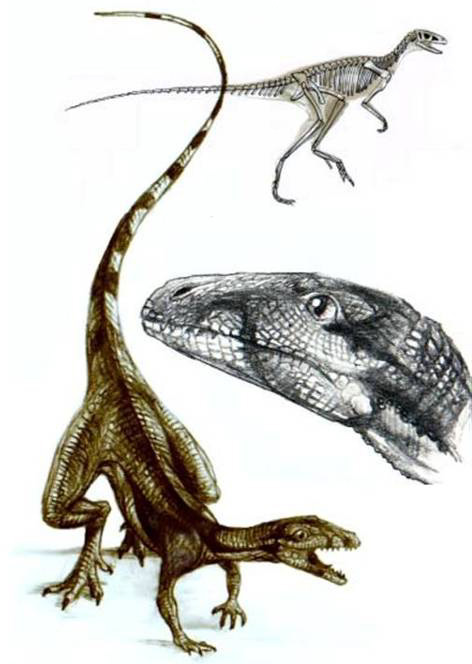|
Gracilisuchus Stipanicicorum
''Gracilisuchus'' (meaning "slender crocodile") is an extinct genus of tiny pseudosuchian (a group which includes the ancestors of crocodilians) from the Late Triassic of Argentina. It contains a single species, ''G. stipanicicorum'', which is placed in the clade Suchia, close to the ancestry of crocodylomorphs. Both the genus and the species were first described by Alfred Romer in 1972. Discovery Discovery of the holotype A four-month expedition spanning 1964 and 1965 in the Ischigualasto-Villa Unión Basin of La Rioja Province, Argentina was conducted by Alfred Romer and his colleagues, who consisted of researchers from the Museum of Comparative Zoology (MCZ) at Harvard University. While the first two months of the expedition were unfruitful, excavations near the Chañares River and the Gualo River, soon uncovered specimens belonging to a wide variety of tetrapod groups. Among these was the skeleton of a small suchian archosaur, discovered about north of the Chañares River ... [...More Info...] [...Related Items...] OR: [Wikipedia] [Google] [Baidu] |
Carnian
The Carnian (less commonly, Karnian) is the lowermost stage of the Upper Triassic Series (or earliest age of the Late Triassic Epoch). It lasted from 237 to 227 million years ago (Ma). The Carnian is preceded by the Ladinian and is followed by the Norian. Its boundaries are not characterized by major extinctions or biotic turnovers, but a climatic event (known as the Carnian pluvial episode characterized by substantial rainfall) occurred during the Carnian and seems to be associated with important extinctions or biotic radiations. Stratigraphic definitions The Carnian was named in 1869 by Mojsisovics. It is unclear if it was named after the Carnic Alps or after the Austrian region of Carinthia (''Kärnten'' in German) or after the Carnia historical region in northwestern Italy. The name, however, was first used referring to a part of the Hallstatt Limestone cropping out in Austria. The base of the Carnian Stage is defined as the place in the stratigraphic record where t ... [...More Info...] [...Related Items...] OR: [Wikipedia] [Google] [Baidu] |
Stratigraphy
Stratigraphy is a branch of geology concerned with the study of rock (geology), rock layers (Stratum, strata) and layering (stratification). It is primarily used in the study of sedimentary rock, sedimentary and layered volcanic rocks. Stratigraphy has three related subfields: lithostratigraphy (lithologic stratigraphy), biostratigraphy (biologic stratigraphy), and chronostratigraphy (stratigraphy by age). Historical development Catholic priest Nicholas Steno established the theoretical basis for stratigraphy when he introduced the law of superposition, the principle of original horizontality and the principle of lateral continuity in a 1669 work on the fossilization of organic remains in layers of sediment. The first practical large-scale application of stratigraphy was by William Smith (geologist), William Smith in the 1790s and early 19th century. Known as the "Father of English geology", Smith recognized the significance of Stratum, strata or rock layering and the importance ... [...More Info...] [...Related Items...] OR: [Wikipedia] [Google] [Baidu] |
Type Species
In zoological nomenclature, a type species (''species typica'') is the species name with which the name of a genus or subgenus is considered to be permanently taxonomically associated, i.e., the species that contains the biological type specimen(s). Article 67.1 A similar concept is used for suprageneric groups and called a type genus. In botanical nomenclature, these terms have no formal standing under the code of nomenclature, but are sometimes borrowed from zoological nomenclature. In botany, the type of a genus name is a specimen (or, rarely, an illustration) which is also the type of a species name. The species name that has that type can also be referred to as the type of the genus name. Names of genus and family ranks, the various subdivisions of those ranks, and some higher-rank names based on genus names, have such types. [...More Info...] [...Related Items...] OR: [Wikipedia] [Google] [Baidu] |
Miguel Lillo
Miguel Ignacio Lillo (26 July 1862, in San Miguel de Tucumán – 4 May 1931, in San Miguel de Tucumán) was an Argentine naturalist and professor. Early life and education Born in the city of San Miguel de Tucuman in 1862, Lillo was related to Lastenia Blanco, and journalist, Emilio J. Schleh. Miguel Lillo studied at the National School of Tucumán, graduating in 1881, but could not afford to continue formal university studies. Career Lillo was passionately devoted to various scientific studies, especially those pertaining to nature. After his formal education, he continued working as an assistant pharmacist in the Physics and Chemistry laboratories of the National College. By 1883 he had amassed a collection of plants from his local area comprising 700 specimens. He went to the National University of Córdoba for guidance from Federico Kurtz and the brothers, Oscar and Adolfo Döring and from whom he gained an appreciation of classification. In 1888 he published an int ... [...More Info...] [...Related Items...] OR: [Wikipedia] [Google] [Baidu] |
José Bonaparte
José Fernando Bonaparte (14 June 1928 – 18 February 2020) was an Argentine paleontologist who discovered a plethora of South American dinosaurs and mentored a new generation of Argentine paleontologists . One of the best-known Argentine paleontologists, he has been described by paleontologist Peter Dodson as "almost singlehandedly ... responsible for Argentina becoming the sixth country in the world in kinds of dinosaurs". Biography Bonaparte was the son of an Italian sailor, with no close connection to Napoleon's House of Bonaparte. He was born in Rosario, Santa Fe, Argentina, and grew up in Mercedes, Buenos Aires. Despite a lack of formal training in paleontology, he started collecting fossils with many friends at an early age, and created a museum in their home town. He later became the curator of the National University of Tucumán, where he was named ''Doctor Honoris causa'' in 1976, and then in the late 1970s became a senior scientist at the Museo Argentino de Cienci ... [...More Info...] [...Related Items...] OR: [Wikipedia] [Google] [Baidu] |
Lagosuchus
''Lagosuchus'' is an extinct genus of avemetatarsalian archosaur from the Late Triassic of Argentina. The type species of ''Lagosuchus'', ''Lagosuchus talampayensis,'' is based on a small partial skeleton recovered from the early Carnian-age Chañares Formation. The holotype skeleton of ''L. talampayensis'' is fairly fragmentary, but it does possess some traits suggesting that ''Lagosuchus'' was a probable dinosauriform, closely related to dinosaurs. A second potential species of ''Lagosuchus'', ''L. lilloensis'', is based on an assortment of slightly larger and more well-preserved fossils. These larger specimens have been considered much more diagnostic and informative than the original small ''L. talampayensis'' skeleton. As a result, some paleontologists have placed the larger specimens into a new genus, ''Marasuchus''. ''Marasuchus'' is generally considered one of the more complete early dinosauriforms, useful for estimating ancestral traits for the origin of dinosaurs. This ... [...More Info...] [...Related Items...] OR: [Wikipedia] [Google] [Baidu] |
Coracoid
A coracoid (from Greek κόραξ, ''koraks'', raven) is a paired bone which is part of the shoulder assembly in all vertebrates except therian mammals (marsupials and placentals). In therian mammals (including humans), a coracoid process is present as part of the scapula, but this is not homologous with the coracoid bone of most other vertebrates. In other tetrapods it joins the scapula to the front end of the sternum and has a notch on the dorsal surface which, along with a similar notch on the ventral surface of the scapula, forms the socket in which the proximal end of the humerus (upper arm bone) is located. The acrocoracoid process is an expansion adjacent to this contact surface, to which the shoulderward end of the biceps brachii muscle attaches in these animals. In birds (and generally theropods and related animals), the entire unit is rigid and called scapulocoracoid. This plays a major role in bird flight. In dinosaurs the main bones of the pectoral girdle were the sca ... [...More Info...] [...Related Items...] OR: [Wikipedia] [Google] [Baidu] |
Gastralium
Gastralia (singular gastralium) are dermal bones found in the ventral body wall of modern crocodilians and tuatara, and many prehistoric tetrapods. They are found between the sternum and pelvis, and do not articulate with the vertebrae. In these reptiles, gastralia provide support for the abdomen and attachment sites for abdominal muscles. The possession of gastralia may be ancestral for Tetrapoda and were possibly derived from the ventral scales found in animals like rhipidistians, labyrinthodonts, and ''Acanthostega'', and may be related to ventral elements of turtle plastrons. Similar, but not homologous cartilagenous elements, are found in the ventral body walls of lizards and anurans. These structures have been referred to as inscriptional ribs, based on their alleged association with the inscriptiones tendinae (the tendons that form the six pack in humans). However, the terminology for these gastral-like structures remains confused. Both types, along with sternal rib ... [...More Info...] [...Related Items...] OR: [Wikipedia] [Google] [Baidu] |
Type (biology)
In biology, a type is a particular specimen (or in some cases a group of specimens) of an organism to which the scientific name of that organism is formally attached. In other words, a type is an example that serves to anchor or centralizes the defining features of that particular taxon. In older usage (pre-1900 in botany), a type was a taxon rather than a specimen. A taxon is a scientifically named grouping of organisms with other like organisms, a set that includes some organisms and excludes others, based on a detailed published description (for example a species description) and on the provision of type material, which is usually available to scientists for examination in a major museum research collection, or similar institution. Type specimen According to a precise set of rules laid down in the International Code of Zoological Nomenclature (ICZN) and the International Code of Nomenclature for algae, fungi, and plants (ICN), the scientific name of every taxon is almost al ... [...More Info...] [...Related Items...] OR: [Wikipedia] [Google] [Baidu] |
National University Of La Rioja
The National University of La Rioja ( es, Universidad Nacional de La Rioja, UNLAR) is an Argentine national university, situated in the city of La Rioja, capital of La Rioja Province. Its precursor, the Provincial University of La Rioja, was established in 1972. See also * List of universities in Argentina External links Science and Education in Argentina 1993 establishments in Argentina La Rioja
La Rioja () is an autonomous community and province in Spain, in the north of the Iberian Peninsula ...
[...More Info...] [...Related Items...] OR: [Wikipedia] [Google] [Baidu] |
_(20406119102).jpg)

_(2).jpg)

.jpg)
